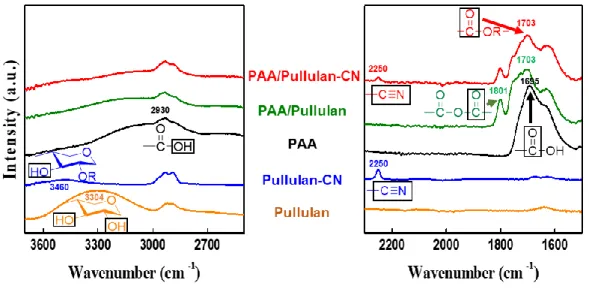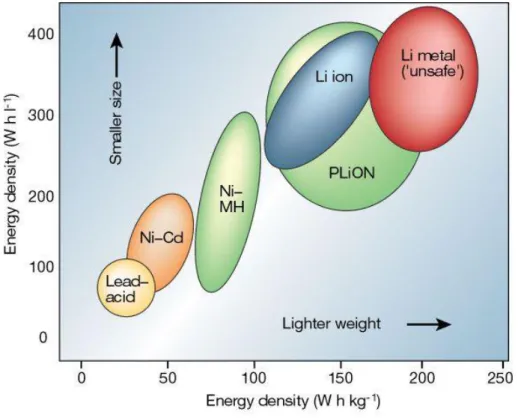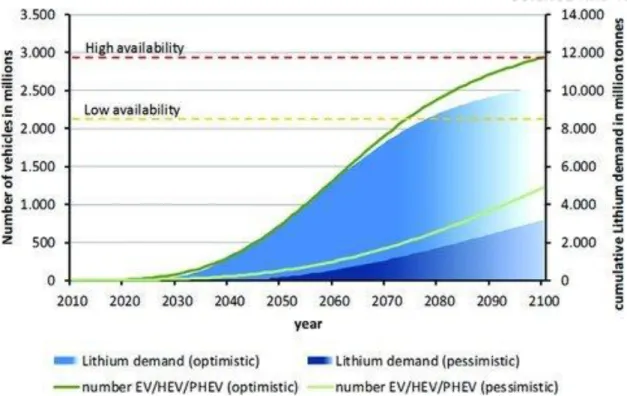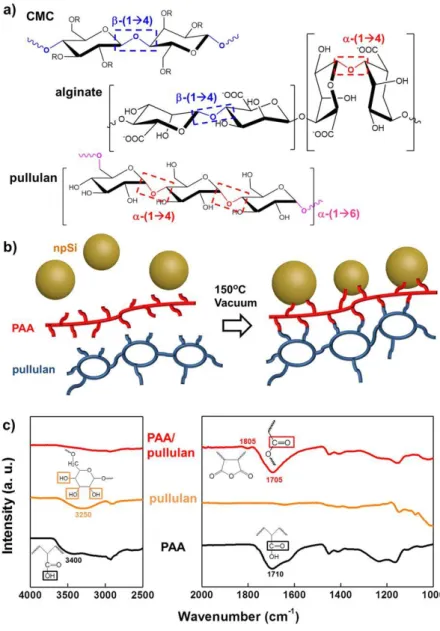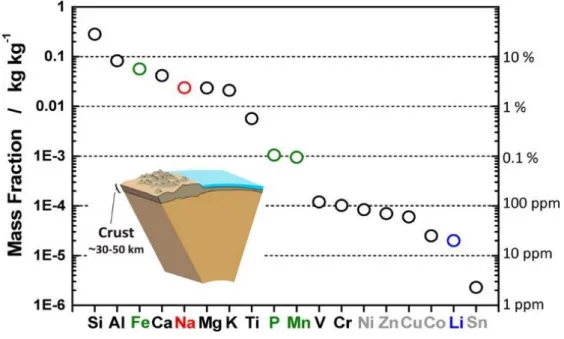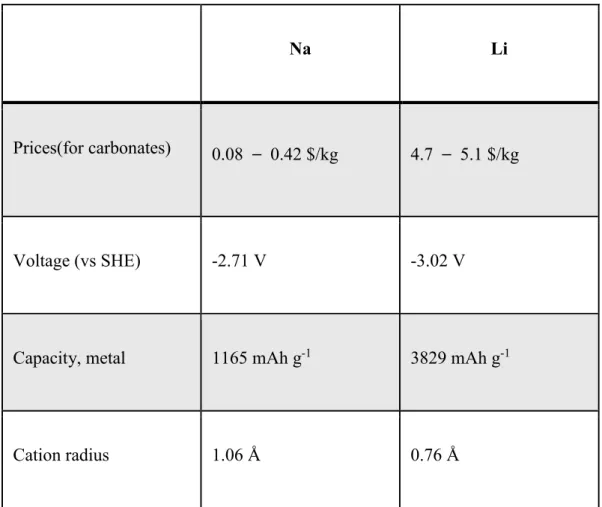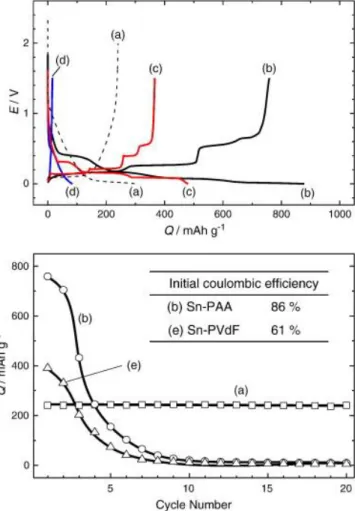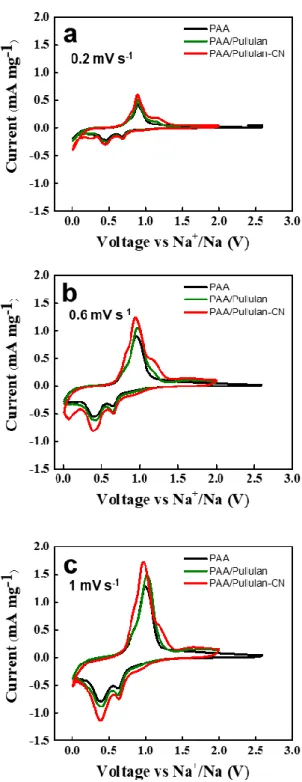Antimony has been developed as a promising anode material of sodium ion batteries (SIBs), although its volume expands violently during the alloying reaction with sodium. Also, a low cation transfer number for sodium ion is another collection of SIBs. In this work, a binder for antimony in SIB cells was designed to have bifunctionality to improve (1) the mechanical toughness to suppress the severe volume change and (2) the transfer number of sodium ions. The polysaccharide backbone of pullulan-CN was responsible for the mechanical toughness, while the cyanoethyl groups were enhanced by pullulan-CN.
Number of lithium demand, availability, electric vehicles (EVs), hybrid electric vehicles (HEVs), and plug-in hybrid electric vehicles (PHEVs) over time. Dehydration reactions are induced at 150 °C between the carboxyl moieties of PAA and the hydroxyl moieties of pullulan and the surface silicon oxide. Disappearance of hydroxyl and carboxylate moieties in cross-linked polymers, appearance of ester moieties of cross-linked bi-polymer binders and remaining nitrile groups, measured by FT-IR spectra.
1 C rate charge/discharge cycles containing different binders of (a) polyacrylic acid (PAA), (b) cross-linked PAA/Pullulan, and (c) cross-linked PAA/Pullulan-CN at initial condition, for pristine, 1. sodiation, 1. sodiation desodiation, and 100. desodiation pictures. The comparison with our works and other reported electrodes which contain antimony in sodium ion battery anodes. After the filtration, dry antimony particles at 80 oC, vacuum condition, and then put the powder into the freeze dryer at -120 oC condition. schematic figure of binder-coated separator for measurement of transfer number.
Cross-linked polymer binder network formed by dehydration reaction between polyacrylic acid and Pullulan or Pullulan-CN. b) Enhancement of sodium ion transfer around the electrode facilitated by pullulan-CN binder compared to PAA.
Importance of secondary batteries in the future
According to the availability of lithium and the demand for EV/HEV/PHEV, may run out of lithium in the near future.
Introduction of alloy anode materials for lithium ion batteries (LIBs)
Recent studies for binders to improve alloy anode materials in LIB system
The anode electrode consists of four representative components, current collector, active material, conductive additives and binders. Anode current collector collects electrons at the outer conductor and then supplies electron to active materials, active materials make capacity by reacting with Li ions, conductive additives (such as carbon black) increase the conductivity of electrode. Adhesive and cohesion binders mainly used for binder, they connect current collector, active material and conductive agent and then keep the integrity of electrode by adhesion (current collector - active material) and cohesion (active material - another active material or conductive agent) .
Four components of anode electrode; Brown plate = current collector, large gray sphere = active material, small black sphere = conductive additive, blue strand = binders. It has been reported that the volume change of the alloy reaction-based anode materials and its following effects were suppressed by adopting binders with appropriate properties. Mechanically tough polymeric binders such as alginate26, carboxymethyl cellulose (CMC)27, amylopectin28 and pullulan4, are essential to maintain electrode integrity and suppress pulverization.
Binders that form a strong bond with surface of active material such as poly(acrylic acid) (PAA)29, guar gum30 and 5-methyl-5-(4-vinylbenzyl) Meldrum's acid31 improved the reversibility of silicon due to the covalent bond or hydrogen bonding between the binders and surface oxide of active material. Furthermore, the bi-polymer system of mechanical toughness polymer and strong binding polymer, such as cross-linking of PAA with pectin3 (Figure 3), CMC32 or pullulan4 (Figure 4) via condensation is essential to form branched structure, which strengthens the mechanical strength and reversibility of the silicon. This branched architecture of bi-polymer binder systems provides more enhanced reversibility of lithiation/delithiation of silicon via interchain cohesion.33, 34.
Polysaccharides polymeric binders characterized by glycosidic bonds between their monomeric units and functional parts on side chains.
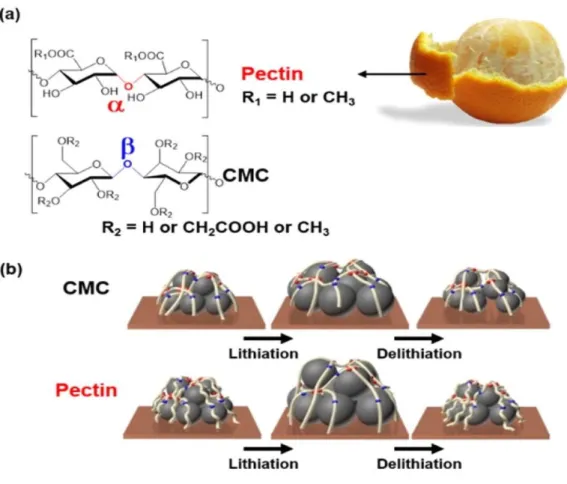
Comparison of LIB and sodium ion batteries (SIBs)
Introduction of anode materials for SIBs
Recent studies for binders to improve alloy anode materials in SIB system
This crosslinking inhibits the volume expansion of the alloy materials, showing better cyclability compared to conventional binders such as PVDF (polyvinylidene fluoride) or uncrosslinked chitosan. top) Initial charge and discharge profiles and (bottom) cyclability of (a) hard carbon with PVdF linker, (b) Sn-PAA, (c) Pb-PAA, (d) Si-PAA, and (e) Sn - PVdF. Solid carbon electrodes were characterized in beaker-type Na cells at 25 mA g-1, and Sn, Pb, Si and Sn-based electrodes were tested in coin-type cells at 50 mA g-1 in 1.0 M NaClO4 PC .
Other problems of SIBs anode and strategies to solve this problem
Cyclability and coulombic efficiency along continuous cycles of lithiation and delithiation at 25 oC (a) and 60 oC. b) Rate performance of silicon anodes. Control of delithiation of silicon anodes with lithiation fixed at 0.2 C (c) Same lithiation/delithiation C rate was used for (d).
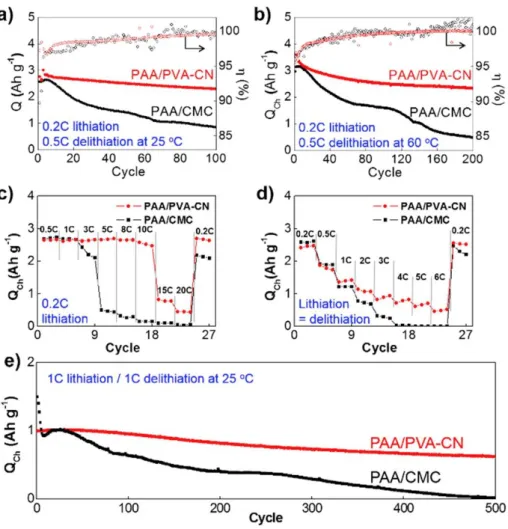
A crosslinked binder to enhance the performance of antimony anode
- Experimental method and materials
- Binder & Antimony preparation
- Cell preparation
- Mechanical characterization
- Electrochemical characterization
- Material characterization
- Results and discussion
- Conclusion
- Reference
The PAA/pullulan-CN based antimony anodes were prepared to have the cross-link between PAA and pullulan-CN and strong bonds between PAA and antimony. The anode suspension containing antimony particles with PAA/pullulan-CN was coated on copper current collectors. Nitrile functional groups of pullulan-CN and PAA/pullulan-CN were observed at the wavelength 2250 cm-1.
PAA became mechanically stiffer after being cross-linked with polysaccharide: modulus of elasticity = 1.75 MPa for PAA/pullulan and 4.68 MPa for PAA/pullulan-CN. The active layer containing PAA/pullulan-CN was the most difficult to separate, indicating the strongest adhesion. The entire mass of the active layer based on PAA/pullulan-CN was peeled off from the foil and after peeling it was found on the 3M Magic tape.
It confirmed that PAA/pullulan-CN guaranteed the strong cohesion between the electrode components (antimony and carbon black) and therefore the integrity of the electrode. The cyanoethyl side chains of the pullulan-CN linker play an important role to increase the dielectric constant. The superiority of the transfer number and melting ability of PAA/pullulan-CN supported the full utilization of antimony active mass in the composite electrodes.
61 , 62 Higher currents were obtained from the PAA/pullulan-CN-based antimony anode than its controls. The ECSA of PAA/pullulan-CN-based electrode is about 1.5 times greater than that of PAA/pullulan or PAA-based electrode. The highest initial coulombic efficiency was obtained from PAA/pullulan-CN compared to the controls: 70%.
The PAA/pullulan-CN was also superior to the controls in terms of recyclability at both 0.2 °C and 1 °C (Figure 11b and c). The rate performance obtained from the PAA/pullulan-CN cells is considered very excellent compared to that of previously reported works (Table 2 and Figure 12). In this work, we presented PAA/pullulan-CN as the effective binder for antimony anode of SIBs.
Liu, S.; Feng, J.; Bian, X.; Liu, J.; Xu, H., Morphology-controlled synthesis of nanoporous antimony anode for high-performance sodium ion batteries. Huang, B.; Wang, Z.; Chen, L.; Xue, R.; Wang, F., Mechanism of lithium ion transport in polyacrylonitrile-based polymer electrolytes.
